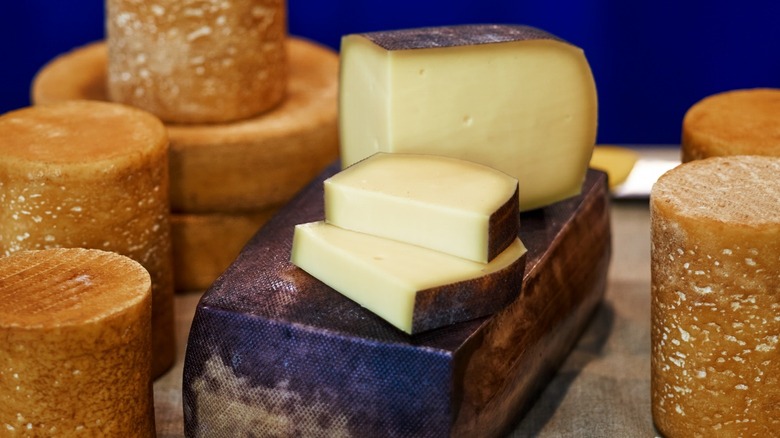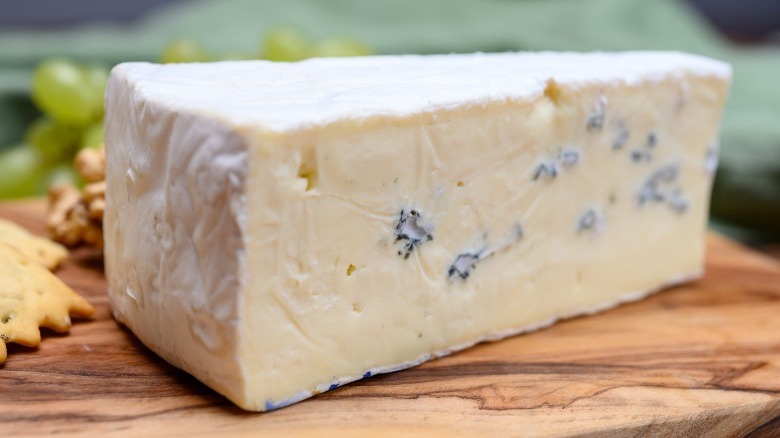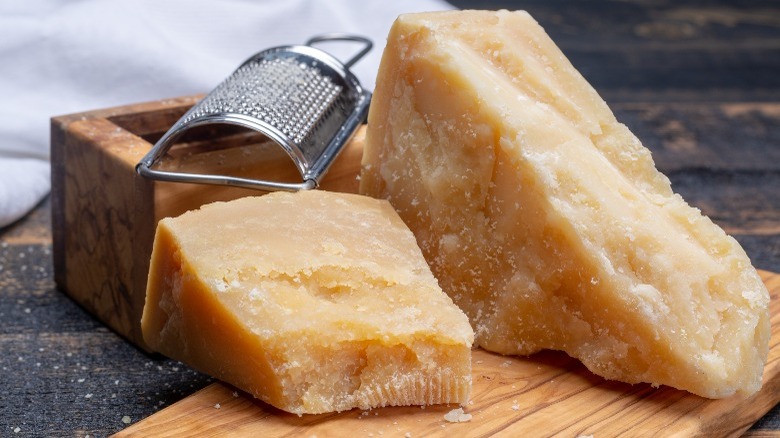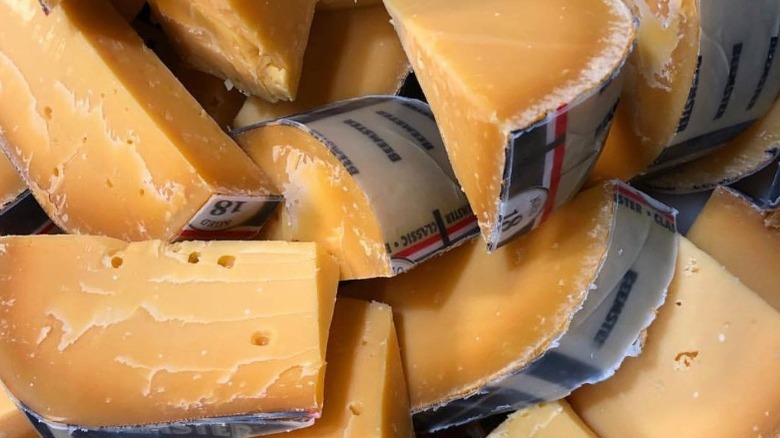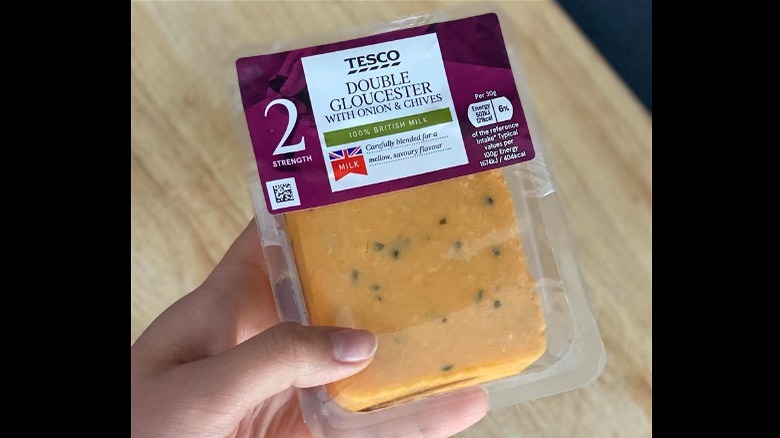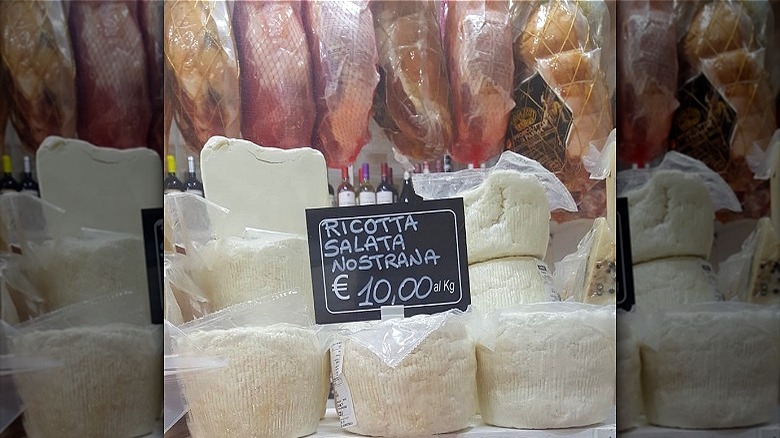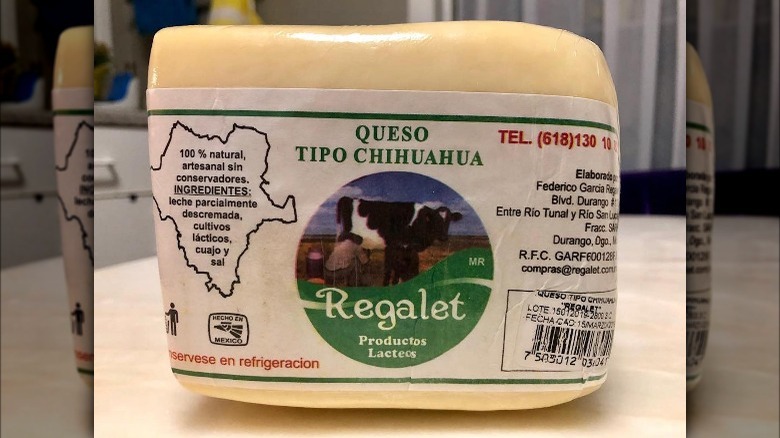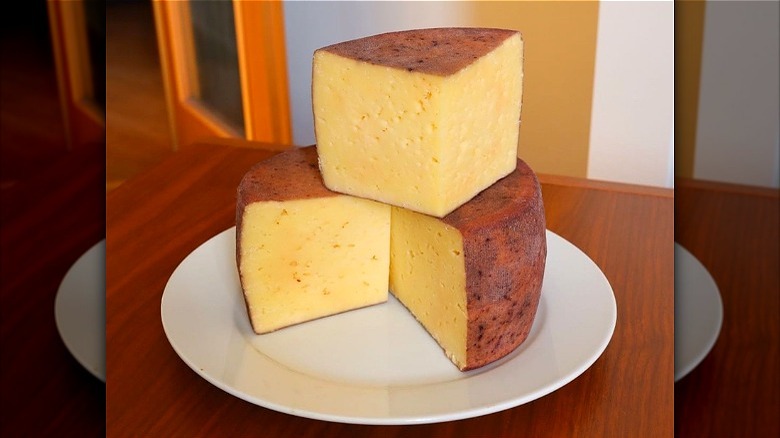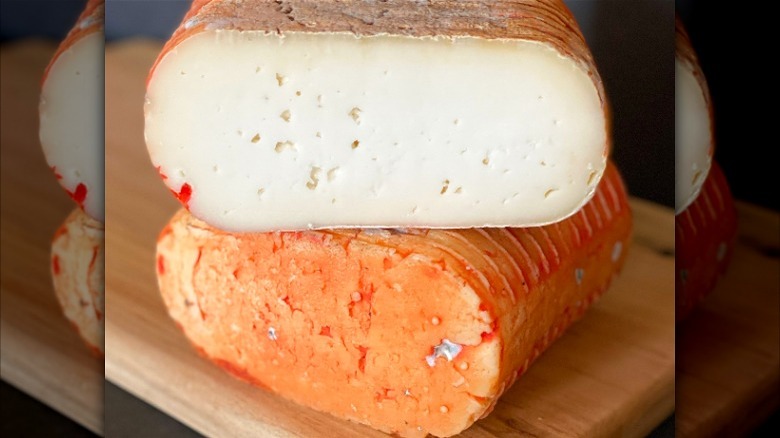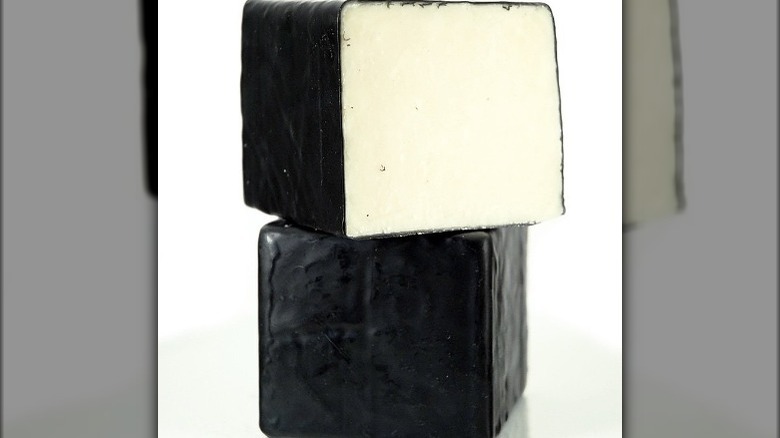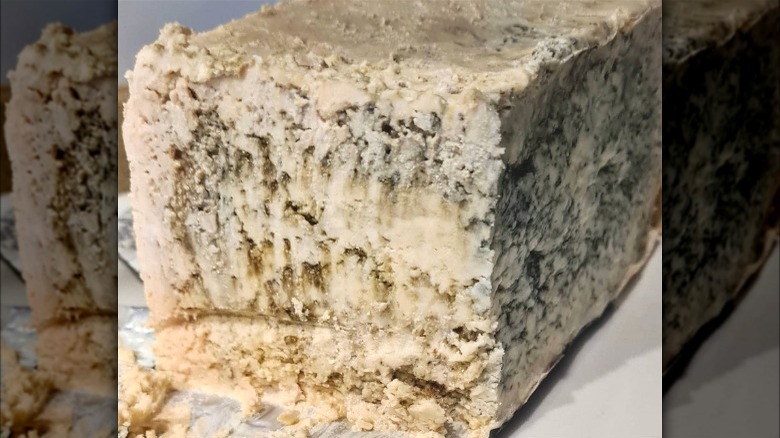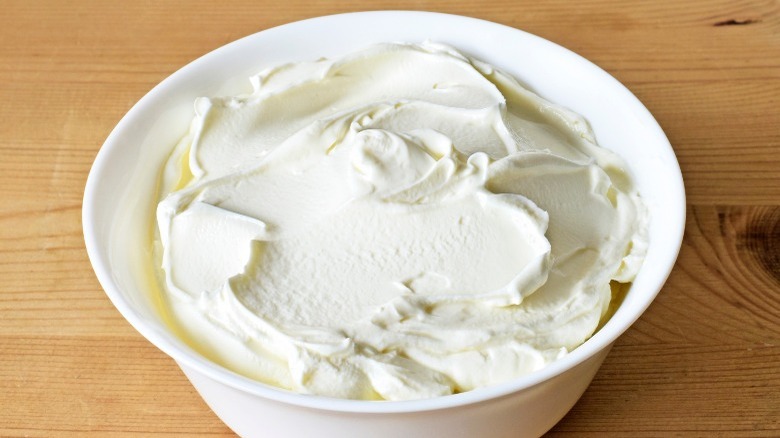Underrated Cheeses You'll Wish You Knew About Sooner
Humans have been producing cheese for more than 4,000 years, according to the International Dairy Food Association. In that time, we've developed a fond love affair with the sometimes gooey and sometimes stinky dairy product, adding it to pizzas, sandwiches, pasta dishes, and displaying it as the star of the show on cheese boards. Today, there are actually over 1,800 different kinds of cheeses worldwide (via Wisconsin Cheese). So even if you have your favorite go-to, there's always room to experiment with new cheeses. Why not swap out your mozzarella and cheddar with something more exciting?
If you have a local cheesemonger, don't be shy about asking for some guidance. They'll let you taste new products and can walk you through the right cheese to try based on your palate and preference. For a head start, keep reading to discover some underrated cheeses that will help you break out of your routine and add a fresh twist to your next cheese platter.
Cambozola
If you can't decide between triple cream cheese or blue cheese, look no further than Cambozola. Developed in southern Germany, it really has the best qualities of each and it's perfect for the indecisive — and the adventurous — among us! You might have already picked up on its unique name: Cambozola is a trademarked combination of Gorgonzola and Camembert. According to the Cambozola website, the cheese was created in 1980 as a way to blend the melty, gooey qualities of Camembert with the tanginess of blue cheese.
It's certainly a dream on cheese boards thanks to these combined characteristics. It works with all of the typical blue cheese fixings and it goes equally well with common soft cheese fixings. And there are also some recipes on the Cambozola website that incorporate it into all sorts of preparations, including Cambozola stuffed dates with Parma ham and Cambozola polenta gnocchi with radicchio jam.
Parmigiano Reggiano
Parmigiano Reggiano isn't actually underrated at all, and in fact, it's widely regarded as a top-notch cooking cheese. You may have used it for your cacio e pepe pasta or to garnish a plate of tomato spaghetti. What we usually buy in the United States is Parmesan, simply the English iteration of the word Parmigiano.
Much like Champagne, Parmigiano Reggiano can only be made in a specific region and according to set conditions. The cheese falls under Protected Designation of Origin (PDO) status and may only be made in the following cities: Bologna, Modena, Mantua, Parma, or Reggio Emilia. Parmigiano Reggiano's official website states that the cow's milk cheese dates back to the Middle Ages when monks sought out a way to create a long-lasting product. It must be aged for at least 12 months, but some producers mature it for longer periods of time.
The cheese is often a blend of nutty, salty, and bitter flavors with an herbaceous undertone. While we commonly use it for cooking, it works just as well crumbled and added to a cheese plate. Just serve it with some honey, nuts, and dried fruits to bring out the salty and savory notes. You can also drop the rind into soups to add a rich umami flavor.
Beemster
There's a good chance you've heard of Gouda, which has a reputation as being the perfect melty cheese for an unmatched macaroni and cheese. If you're a fan of Gouda, then may we suggest you try a specific type called Beemster. It's softer, creamier, and richer, which makes it a delicious alternative to more generic styles of Gouda.
In a little pocket of North Holland is a region called the Beemster Polder. The terrain here is made up of clay soil that's rich in minerals; and in this environment, the cows graze and produce high-quality milk (via Beemster Cheese). This milk is used to make Beemster cheese, and you can instantly taste the difference. The cheese dates back to 1901 and producers still hold onto some traditions today like stirring the cheese curds by hand. You can incorporate Beemster into the same recipes where you would use Gouda, but if you really want to see it shine, add it to a cheese board.
Double Gloucester
Gloucester is a cheese enjoyed across England, but it isn't quite as ubiquitous in the US. According to The Courtyard Dairy, at certain farms, Double Gloucester was once made using cream from the evening milking combined with the following day's milk, whereas Single Gloucester was made using skimmed or morning milk. However, the outlet notes that the fat content of the two cheeses has typically been the same, and this practice may not have been so common. As for the maturing stage, Double Gloucester ages longer than Single Gloucester, which can produce a more robust flavor.
Gloucester cheese comes from the milk of Gloucester cows, which are unfortunately facing extinction according to BBC. It's believed to be one of the first colored cheeses, as cheesemakers used natural colorings like saffron and carrot to dye it in the 17th century (via Cheese of the Month Club). There's quite an interesting history around Gloucester, and it's just as delicious as it's ever been. If you're lucky enough to find it in a store near you, you should pick up on some notes of nuttiness, as well as a buttery and flaky texture.
Ricotta Salata
Ricotta salata is one of the few kinds of cheese on this list that can't stand on its own. It's not a cheese platter cheese or a snacking cheese, and you'll likely be very disappointed if you tuck into it expecting a big flavor and texture. But what ricotta salata lacks in bold flavor, it more than makes up for with nuance and individuality.
As its name suggests, it is related to ricotta, and salata indicates the addition of salt. The cheese is pressed, salted, dried, and then aged for three months as it takes on a more solid form (via Taste Atlas). Ricotta salata is a sheep's milk cheese but because it is firmer than regular ricotta, it's often sold as a wheel, wedge, or small chunk. If you're looking for a substitute for Pecorino Romano, another sheep's milk cheese, swap in some ricotta salata. Alternatively, try it in a salad with some dinosaur kale, shallots, oil, and vinegar.
Chihuahua
Tex-Mex dishes like quesadillas and burritos typically come loaded up with cheese. Often, Monterey Jack, Colby Jack, or cheddar are used, but in more authentic Mexican preparations, queso Chihuahua is typical. The cheese is made from cow's milk in the Mexican state of Chihuahua. The texture is gooey and it has plenty of melt-appeal that makes it perfect for Mexican dishes and almost any other preparation where you need something melty and delicious.
The Mennonites who first migrated to Mexico in the 1920s were responsible for introducing the cheese, which explains why you may see it labeled queso Menonita (via Eating The World). The semi-soft cheese is pale yellow in color and doesn't have a particularly strong or overpowering flavor. All the same, you should be able to pick up some buttery notes as well as hints of cheddar. You can add queso Chihuahua to any recipe that might call for mozzarella or use it in your favorite Tex-Mex or Mexican dishes.
Ubriaco Cheese
In the Treviso region of Italy during World War I, farmers wanted to keep their wheels of cheese safe. So, they stored them in red wine barrels in the hopes that they would be hidden from invading forces, according to Chefs Mandala. When they finally retrieved the cheese, the rinds were bright purple, giving it the name Ubriaco (drunk) cheese. Another (slightly less exciting) version of the story is that the cheese was submerged in wine must as a preservation method before other practices became more common (via Fortuna's Sausage & Italian Market)
Whatever the true history, Ubriaco has a pleasant and distinct flavor. The cheese is made from cow's milk and today, it is often aged for six months before being dunked in grape must. Taste Atlas recommends pairing it with a fuller Italian red wine like Primitivo or Montepulciano for a delicious experience. And on a cheese plate, you don't need to do much to make this cheese pop — the bright purple rind is impressive enough.
Pata Cabra
Pata Cabra is a washed-rind goat's milk cheese from Sagrossa, Spain according to IGourmet. The name means goat leg, in part because of its shape but also because it's made from goat's milk. You might not be able to find it easily since the rare cheese is handmade in small quantities. However, if you manage to source some, you won't be disappointed.
Pata Cabra has a typical goat cheese tang, along with pungent and fruity notes (via IGourmet). The texture is smooth and gooey, yet it still has an excellent chew to it which makes it a welcome addition to a cheeseboard. If you've been curious about trying fuller-bodied styles of goat cheese, then Pata Cabra is definitely one to taste. It's unique while still being similar enough to what you've probably already tasted, which makes it easy to appreciate. Gourmet Sleuth recommends pairing it with dry Riesling wine and enjoying it with grapes and nuts.
Chèvre Noir
Cheese made from goat's milk is almost always a safe bet — unless you are lactose intolerant since it still contains lactose. Nonetheless, in addition to having an impeccably tart, creamy, and earthy flavor, it can be just as versatile as cow's milk cheese, both on cheese boards and in recipes.
Take Le Chèvre Noir for example. This goat's milk cheese from Québec has a striking black wax rind and seems eerily similar to cheddar. It has a delightful crunch from lactose crystals, and the flavor is rich and nutty with notes of caramel (via Cheesebar). The texture is harder than you may expect from a goat's cheese which adds to its unique nature. Chèvre Noir is the type of cheese you bring out for guests you want to impress, and it also works as a memorable housewarming gift for your foodie friends.
Cabrales
Asturias in the very north of Spain is the home of Cabrales, a bold in-your-face blue cheese. This cheese is definitely more powerful and delicious than you might expect from its questionable appearance. While it was once made from either cow's, goat's, or sheep's milk, today cow's milk is primarily used, according to Culture Cheese Mag.
The outlet explains that the cheese is set aside to age in cool limestone caves anywhere from two to six months, during which the mold is allowed to proliferate. This is when the magic happens because this mold gives Cabrales cheese its unique and slightly acidic aromas. To this day, it's just produced in small batches where only the traditional methods are used. If you're a fan of more common blue cheeses like Roquefort and Gorgonzola, Cabrales is a nice departure from these familiar options. You'll love this with fig jam and some rosemary crackers as part of a decadent cheese plate.
Quark
Quark is a white cow's milk cheese that is similar to smooth cottage cheese and equally reminiscent of yogurt. With its mild flavor, you'll find that you can actually use it in many of the same ways. For example, add quark to your next cake so that it comes out nice and moist. In fact, in Germany, cheesecakes are made with quark instead of cream cheese for a milder, more savory dessert (via The Domestic Rebel).
Aside from baked goods, you can also use it as a lighter substitute for mayonnaise in coleslaw, or to make a creamy pasta that isn't overwhelmingly rich. Alternatively, treat it like sour cream and dollop it over a baked potato with fresh herbs. Quark is certainly multifaceted in the kitchen and it is conveniently sold in jars or tubs. Plus, it's a great way to satiate your hunger as it has more protein than Greek yogurt (via Nutrition Advance).
